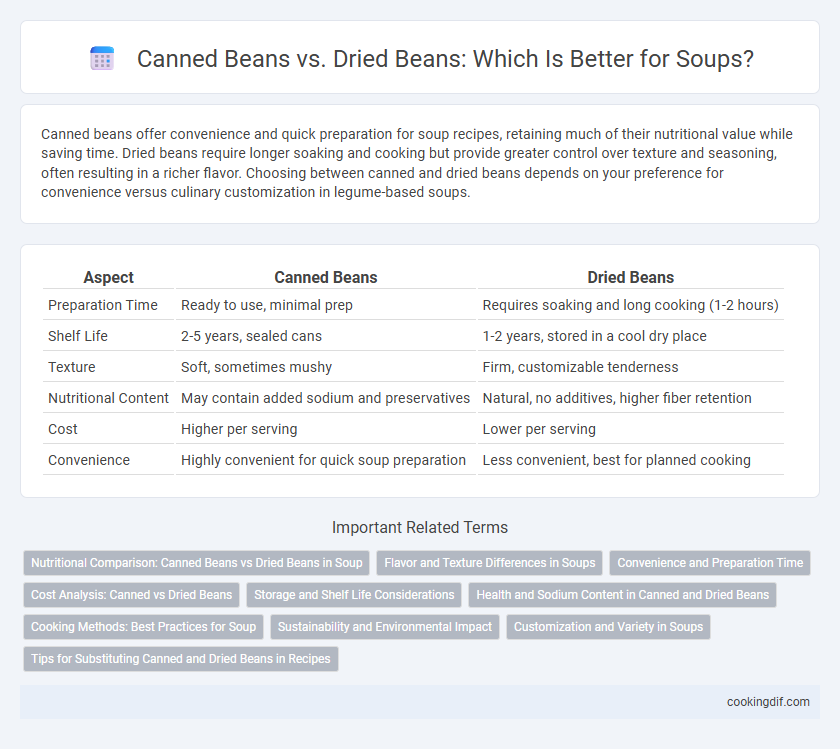Canned beans offer convenience and quick preparation for soup recipes, retaining much of their nutritional value while saving time. Dried beans require longer soaking and cooking but provide greater control over texture and seasoning, often resulting in a richer flavor. Choosing between canned and dried beans depends on your preference for convenience versus culinary customization in legume-based soups.
Table of Comparison
| Aspect | Canned Beans | Dried Beans |
|---|---|---|
| Preparation Time | Ready to use, minimal prep | Requires soaking and long cooking (1-2 hours) |
| Shelf Life | 2-5 years, sealed cans | 1-2 years, stored in a cool dry place |
| Texture | Soft, sometimes mushy | Firm, customizable tenderness |
| Nutritional Content | May contain added sodium and preservatives | Natural, no additives, higher fiber retention |
| Cost | Higher per serving | Lower per serving |
| Convenience | Highly convenient for quick soup preparation | Less convenient, best for planned cooking |
Nutritional Comparison: Canned Beans vs Dried Beans in Soup
Canned beans retain much of their nutritional value, providing a convenient source of protein, fiber, and essential minerals, though they often contain added sodium compared to dried beans. Dried beans require soaking and longer cooking times, but they typically offer higher nutrient density with lower sodium content and no preservatives. For soup recipes, choosing dried beans can result in a richer nutrient profile, while canned beans offer speed and ease with a slight trade-off in sodium levels.
Flavor and Texture Differences in Soups
Canned beans offer a softer texture and a more uniform flavor, making soups creamier and quicker to prepare. Dried beans require soaking and longer cooking time but provide a firmer texture and deeper, earthier flavor that enhances the complexity of soups. Choosing between canned and dried beans impacts the soup's overall mouthfeel and taste profile significantly.
Convenience and Preparation Time
Canned beans offer superior convenience and significantly reduced preparation time compared to dried beans, as they are pre-cooked and ready to use straight from the can, making them ideal for quick soups and meals. Dried beans require soaking for several hours and extended cooking times, which can exceed an hour depending on the bean type, but they provide greater control over texture and flavor customization. Choosing between canned and dried beans hinges on balancing immediate convenience with the desire for flavor depth and texture control in legume-based soups.
Cost Analysis: Canned vs Dried Beans
Dried beans are significantly more cost-effective than canned beans, with prices often less than half per serving, making them ideal for budget-conscious cooking. While canned beans offer convenience and reduced preparation time, their premium price includes processing and packaging costs that increase overall expense. Bulk purchasing of dried beans further enhances savings, allowing for long-term storage without nutritional compromise, unlike canned alternatives with limited shelf life.
Storage and Shelf Life Considerations
Canned beans offer convenience with a shelf life of 2 to 5 years when stored in a cool, dry place, maintaining their quality without refrigeration before opening. Dried beans can be stored for up to 10 years if kept in airtight containers away from moisture, pests, and heat, preserving their nutritional value and texture over time. Proper storage conditions for both options significantly impact legume freshness and suitability for soup recipes, with dried beans requiring soaking and longer cooking compared to ready-to-use canned beans.
Health and Sodium Content in Canned and Dried Beans
Canned beans provide convenience and quick meal preparation but often contain added sodium, with average sodium levels ranging from 300 to 400 mg per half-cup serving. Dried beans, when soaked and cooked from scratch, offer a sodium-free option, allowing full control over salt content and resulting in a healthier, lower-sodium choice. Opting for no-salt-added canned beans or thoroughly rinsing canned varieties can reduce sodium intake while still benefiting from their ease of use.
Cooking Methods: Best Practices for Soup
Canned beans offer convenience by requiring minimal cooking time and can be directly added to soups after rinsing to reduce sodium content. Dried beans demand soaking for 6-8 hours or overnight and longer simmering, typically 1-2 hours, to achieve optimal texture and flavor integration in soups. Using dried beans allows better control over firmness and reduces the risk of mushy results, enhancing soup consistency and nutrient retention.
Sustainability and Environmental Impact
Dried beans have a lower environmental footprint compared to canned beans due to reduced packaging waste and lesser energy consumption during processing. The production and transportation of canned beans involve higher greenhouse gas emissions and resource use from metal can manufacturing and refrigeration. Choosing dried beans supports sustainable food systems by minimizing plastic and metal waste and decreasing carbon emissions linked to food preservation methods.
Customization and Variety in Soups
Canned beans offer convenience with consistent texture and flavor, ideal for quick soup recipes requiring minimal preparation. Dried beans provide greater customization, allowing control over soaking time, cooking duration, and seasoning to achieve desired firmness and taste. Varied bean types like black, kidney, or navy beans expand soup flavor profiles and nutritional value, with dried beans enabling deeper infusion of spices and broths.
Tips for Substituting Canned and Dried Beans in Recipes
When substituting canned beans for dried beans in soup recipes, drain and rinse canned beans to reduce sodium content and adjust cooking time since canned beans are pre-cooked and require less simmering. For dried beans, soak overnight to reduce cooking time and improve digestibility, then simmer until tender before adding to soups. To maintain flavor and texture, use one cup of dried beans to replace about 2.5 cups of canned beans, accounting for the expansion during cooking.
Canned Beans vs Dried Beans for legume Infographic

 cookingdif.com
cookingdif.com